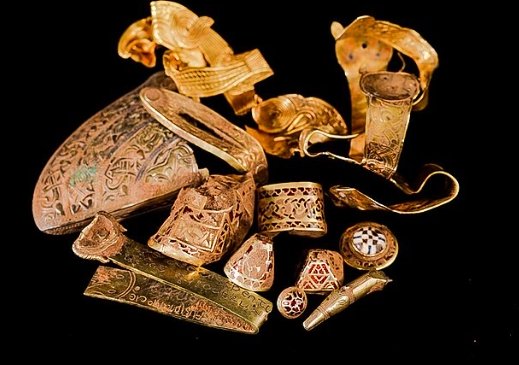In a historic auction, a hoard of 2,584 silver coins uncovered in England’s Chew Valley has just sold for $5.6 million, making it the most valuable treasure ever discovered in the United Kingdom. Found by amateur metal detectorists in 2019, these coins date back to the years immediately following the Norman Conquest of 1066, a period marked by intense upheaval and change in English history.
A Glimpse into England’s Norman Past
The coins are a rare and tangible link to the events surrounding the Norman Conquest. When Edward the Confessor, the Anglo-Saxon king, died in 1066 without an heir, a fierce battle for the English throne ensued. Ultimately, William the Conqueror emerged victorious, becoming the first Norman king of England. This period was characterized by instability, conflict, and cultural transformation as the Normans consolidated power across the English realm.

Historic Figures Etched in Silver
The trove of coins unearthed in Chew Valley features images of key figures from this transitional era. Approximately half of the coins depict William himself, while others feature Harold II, the last Anglo-Saxon king who ruled for only nine months before being killed at the Battle of Hastings. One coin even bears the image of Edward the Confessor, whose death set off the chain of events that led to the Norman takeover.
The coins offer a unique snapshot of life in England around 1066–1068, shedding light on a time when many Anglo-Saxons hid their wealth to protect it from invading forces and local instability.
The Discovery: An Unlikely Find
On January 26, 2019, seven metal detectorists were sweeping through a field in the Chew Valley in southern England when they unearthed something remarkable. Adam Staples and his partner, Lisa Grace, were among those who first realized the magnitude of the discovery. “It was totally unbelievable — to find one would be an exceptional day metal detecting,” Staples told the BBC in 2019. But as they continued, the number of “beeps” from their equipment kept rising, eventually leading them to the full hoard of nearly 2,600 coins.
From Field to Museum
After the initial discovery, Staples and his team reported their find to the Portable Antiquities Scheme at the British Museum, which facilitates the reporting of archaeological finds by the public. Experts soon confirmed that the silver coins dated back nearly 1,000 years to the era of the Norman invasion.
The collection was later examined by historians and numismatists, who marveled at its preservation and historical importance. With the coins now acquired by the South West Heritage Trust for $5.6 million, they have become a permanent part of the national collection. Plans are in place for the coins to go on display at the British Museum before they find a permanent home at the Museum of Somerset.
Coin Designs: A Blend of Art and History
Each coin within the Chew Valley hoard is more than just currency; it’s a small work of art and a historical document in itself. The Norman silver pennies are minted in the style of the period, with inscriptions and images carefully engraved to reflect the rulers of the time.
- Coins of William the Conqueror: These coins capture William’s ambition and strength, marking his transition from the Duke of Normandy to the King of England. With William’s likeness stamped in silver, these coins symbolize his dominance and the Norman victory.
- Coins of Harold II: The coins featuring Harold are especially rare, as his reign was brief, lasting only from January to October 1066. They offer a glimpse into the final months of Anglo-Saxon England before the Normans reshaped the country’s political and cultural landscape.
- Single Coin of Edward the Confessor: This unique coin holds special significance, as Edward’s death without an heir led to the chaotic power struggle that culminated in William’s conquest.
The blend of these different rulers within one collection highlights the intense period of political transition, as England moved from Anglo-Saxon rule to Norman control.
Historical Context: The Norman Conquest and Its Legacy
The Norman Conquest was a transformative moment in English history. After William the Conqueror defeated Harold II at the Battle of Hastings, he initiated a wave of change that included building fortifications, redistributing land, and imposing a new social structure. These events were famously depicted in the Bayeux Tapestry, an embroidered chronicle of the invasion that remains one of history’s most iconic artifacts.
Theories on Why the Coins Were Buried
Experts suggest that the coins were likely buried during the unrest that followed William’s takeover. As resistance against Norman rule grew, especially in the south, many people took steps to protect their wealth by burying it in the ground. For reasons unknown, the owner of the Chew Valley hoard never returned, and the treasure remained hidden for nearly a millennium.
A Record-Breaking Treasure
The sale of the Chew Valley hoard for $5.6 million has set a new record as the most valuable treasure ever found in the UK. The coins’ immense worth not only lies in their precious metal content but in their unparalleled historical value, connecting modern audiences with a distant yet pivotal era in English history.













